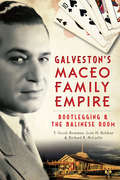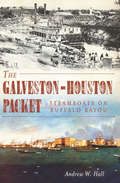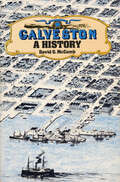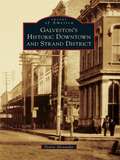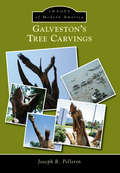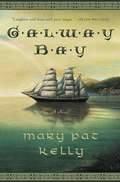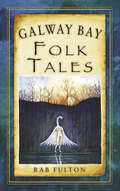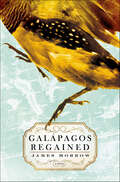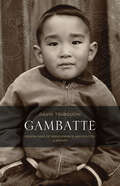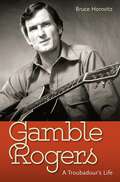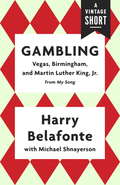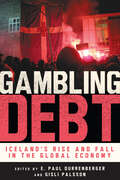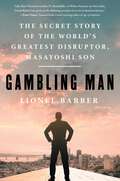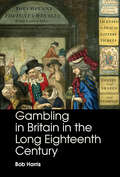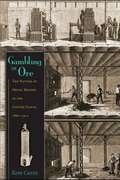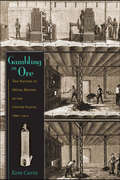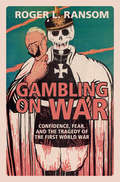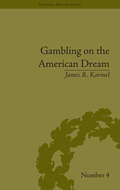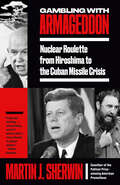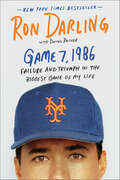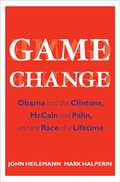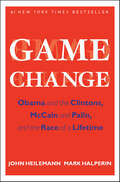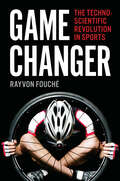- Table View
- List View
Galveston's Maceo Family Empire: Bootlegging and the Balinese Room (True Crime)
by Scott Belshaw T. Nicole Boatman Richard MccaskinAt the dawn of the twentieth century, Galveston was a beacon of opportunity on the Texas Gulf Coast. Dubbed the "Wall Street of the Southwest," its laissez-faire reputation called those hungry for success to its shores. Led by brothers Salvatore and Rosario at the height of Prohibition, the Maceo family answered that call and changed the Oleander City forever. They built an island empire of gambling, smuggling and prostitution that lasted three decades. Housed in their nightclubs frequented by stars like Peggy Lee, Frank Sinatra and Duke Ellington, they endeared themselves to their Galveston neighbors by sharing their profits, imitating crime syndicates in their native Sicily. Though certainly no saints, the Maceos helped bring prosperity to a community weary from a century of turmoil. Discover the history of Galveston's famous crime family with authors Nicole Boatman, Dr. Scott Belshaw and Texas historian Richard McCaslin.
Galveston-Houston Packet, The: Steamboats on Buffalo Bayou
by Andrew W. HallMany imagine the settlement of the American West as signaled by the dust of the wagon train or the whistle of a locomotive. During the middle decades of the nineteenth century, though, the growth of Texas and points west centered on the seventy-mile water route between Galveston and Houston. This single vital link stood between the agricultural riches of the interior and the mercantile enterprises of the coast, with a round of operations that was as sophisticated and efficient as that of any large transport network today. At the same time, the packets on the overnight Houston-Galveston run earned a reputation as colorful as their Mississippi counterparts, complete with impromptu steamboat races, makeshift naval gunboats during the Civil War, professional gamblers and horrific accidents.
Galveston: A History (Fred Rider Cotten Popular History Ser. #15)
by David G. McCombA colorful history of the island city on Texas&’s Gulf Coast and its survival through times of piracy, plague, civil war, and devastating natural disaster. On the Gulf edge of Texas between land and sea stands Galveston Island. Shaped continually by wind and water, it is one of earth&’s ongoing creations, where time is forever new. Here, on the shoreline, embraced by the waves, a person can still feel the heartbeat of nature. And yet, for all the idyllic possibilities, Galveston&’s history has been anything but tranquil. Across Galveston&’s sands have walked Indians, pirates, revolutionaries, the richest men of nineteenth-century Texas, soldiers, sailors, bootleggers, gamblers, prostitutes, physicians, entertainers, engineers, and preservationists. Major events in the island&’s past include hurricanes, yellow fever, smuggling, vice, the Civil War, the building of a medical school and port, raids by the Texas Rangers, and, always, the struggle to live in a precarious location. Galveston: A History is an engrossing account that also explores the role of technology and the often contradictory relationship between technology and the city, providing a guide to both Galveston history and the dynamics of urban development.
Galveston: A History (Fred Rider Cotten Popular History Ser. #15)
by David G. MccombOn the Gulf edge of Texas between land and sea stands Galveston Island. Shaped continually by wind and water, it is one of earth's ongoing creations time is forever new. Here, on the shoreline, embraced by the waves, a person can still feel the heartbeat of nature. And yet, for all the idyllic possibilities, Galveston's history has been anything but tranquil. Across Galveston's sands have walked Indians, pirates, revolutionaries, the richest men of nineteenth-century Texas, soldiers, sailors, bootleggers, gamblers, prostitutes, physicians, entertainers, engineers, and preservationists. Major events in the island's past include hurricanes, yellow fever, smuggling, vice, the Civil War, the building of a medical school and port, raids by the Texas Rangers, and, always, the struggle to live in a precarious location. Galveston: A History is at the forefront of a trend in writing urban biographies emphasizing technology as the dynamic force in urban development. David McComb explores this often contradictory relationship between technology and the city, and provides a guide to both Galveston history and the dynamics of urban development.
Galveston’s Historic Downtown and Strand District
by Denise AlexanderThe Strand, known as the Wall Street of the Southwest, contains a significant collection of 19th-century buildings. Long the center of Galveston's business community, its architecture is a reminder of this historic port city. The National Historic Landmark District includes buildings classified as Greek Revival, Italianate, and Victorian style--sometimes with traces of vernacular building traditions that date to the 1850s. Historic images found within this book illustrate the development of the Strand and surrounding streets, including Mechanic, Market, and Postoffice. Galveston's Historic Downtown and Strand District demonstrates the power of place, despite an ever-changing economy and natural disasters.
Galveston’s Tree Carvings
by Joseph R. PellerinOn September 13, 2008, Hurricane Ike made landfall in Galveston with a 12-foot storm surge that flooded most of the island. The salt water then killed between 40,000 and 50,000 trees in Galveston. After they died, the trees were cut down. A local citizen made the suggestion to carve the stumps into sculptures. Three different professional artists and one amateur artist carved all of the carvings on the island. The first carving was completed in 2009, and the stumps continue to be carved as of 2014. They have become a must-see tourist attraction in Galveston.
Galway Bay
by Mary Pat KellyWhen only a teenager, Honora Keely meets the love of her young life on the beach of her beloved Galway Bay, Ireland. Her Michael, also a teenager, marries her and only a few years later, while they have are in the midst of raising children, Ireland's "Great Hunger" occurs -- the devastating potato famine of the 1840s that killed millions. This is the story of a family's struggle to survive almost insurmountable odds. Honora is a fighter who, with the help of her sister, manages to save enough money for their two families to emigrate to America. In America, Honora forges a whole new life with its own joys and hardships, not the least of which is the Civil War. This gripping family saga beautifully renders an Ireland which was lost to those Irish forced to emigrate to foreign shores.
Galway Bay Folk Tales
by Rab Swannock Fulton Marina WildFrom the saints of the Dark Ages to modern-day sinners, Galway Bay is the source of some of Ireland’s most magical tales. In this book local storyteller Rab Fulton takes the reader through Galway’s past, recalling the myths and legend’s that shaped the area’s history – from the quarrelsome giants who in their rage created the Aran Isles to the corpse that flew through the air at the very first Galway Arts Festival. Also featuring tales of magic swans, miraculous nuns, a city beneath the waves and a cannibal king, this is a great companion for any visit to the county, for fascinating days out and finding exciting treasure on your doorstep.
Galápagos Regained: A Novel
by James MorrowJames Morrow's Galápagos Regained centers on the fictional Chloe Bathurst, an unemployed Victorian actress who finds work on Charles Darwin's estate, nurturing the strange birds, exotic lizards, and giant tortoises he brought back from his trip around the world. When Chloe gets wind of the Great God Contest, sponsored by the Percy Bysshe Shelley Society—£10,000 to the first petitioner who can prove or disprove the existence of a Supreme Being—she decides that Mr. Darwin's materialist theory of speciation might just turn the trick. (If Nature gave God nothing to do, maybe He was never around in the first place.) Before she knows it, her ambitions send her off on a wild adventure—a voyage by brigantine to Brazil, a steamboat trip up the Amazon, a hot-air balloon flight across the Andes—bound for the Galápagos archipelago, where she intends to collect the live specimens through which she might demonstrate evolutionary theory to the contest judges.
Gambatte: A Memoir
by David Tsubouchi”Gambatte” means do your best and never give up, and that spirit is at the heart of David Tsubouchi’s life story. This memoir of the former Ontario cabinet minister begins as his family strives for acceptance amid the imprisonment of Canadians of Japanese descent and the confiscation of their property, possessions, and businesses by the Mackenzie King Liberal government in 1941. Despite growing up on the outside looking in, Tsubouchi never felt disadvantaged because he had a good family and was taught to persevere. Gambatte outlines his unusual career path from actor to dedicated law school student/lumber yard worker to politician. Tsubouchi was the first person of Japanese descent elected in Canada as a municipal politician and, as an MPP, to serve as a cabinet minister. His story also reveals an insider’s perspective of Mike Harris’s “Common Sense Revolution.”
Gamble Rogers: A Troubadour's Life
by Bruce HorovitzFlorida Book Awards, Bronze Medal for Florida Nonfiction Florida Historical Society Charlton Tebeau Award Beloved raconteur, environmentalist, and down-home philosopher, Gamble Rogers (1937–1991) ushered in a renaissance of folk music to a place and time that desperately needed it. In this book, Bruce Horovitz tells the story of how Rogers infused Florida's rapidly commercializing landscape with a refreshing dose of homegrown authenticity and how his distinctive music and personality touched the nation. As a college student, motivated by personal advice from William Faulkner to stay true to himself, Rogers broke away from his family's prestigious architecture business. Rogers was a skilled guitar player and storyteller who soon began performing extensively on the national folk music circuit alongside Pete Seeger, Doc Watson, and Jimmy Buffett. He discovered a special knack for public radio, appearing frequently as a guest commentator on NPR’s All Things Considered. Rogers was known across the country for his intricate fingerpicking guitar style and rapid-fire stage act. Audiences welcomed his humorous homespun tales set in the fictitious Oklawaha County, which was based on places from his own upbringing and populated by a cast of unforgettable characters. His stories evoked rural life in Florida, celebrated the state's natural resources, and called attention to life's many small ironies. As Florida was experiencing colossal growth embodied by the new Kennedy Space Center and Disney World, Rogers's folksy style cheered and reassured listeners in the state who worried that their traditional livelihoods and locales were disappearing. Horovitz shows that even beyond his genius as a performing artist, Rogers was loved for his compassion, integrity, connection with people, and courage. Rogers displayed these widely admired traits for the last time when—on a camping trip to the beach—he tried to save a drowning stranger despite back problems that made it almost impossible for him to swim. This heroic effort led to his untimely death. The life of Gamble Rogers is a window into an important creative subculture that continues to flourish today as contemporary folk artists take on roles similar to the one Rogers established for himself. A modern-day troubadour, Rogers delighted in entertaining audiences with what was familiar and real—by championing the ordinary people of his home community who were closest to his heart.
Gambling
by Harry BelafonteAn eBook short. A participant's portrait of Martin Luther King, Jr. and the Civil Rights Movement, from Harry Belafonte's memoir of activism and entertainment, My Song.Birmingham, Alabama in 1963 was one of the most segregated cities in America. It had segregated lunch counters, restrooms, and water fountains. It had a nickname, "Bombingham," for the homemade bombs detonated by local Klansmen. And it had Eugene "Bull" Connor, a racist police chief with a hair-trigger temper. It was here that Dr. King and his advisers, Harry Belafonte among them, rolled the dice on an enormous action which would rejuvenate the civil rights movement. Harry Belafonte is one of America's greatest entertainers and also one of our most profoundly influential activists. During the 1960s he befriended MLK and began using his celebrity in support of civil rights and other social causes. This is Belafonte's personal story of fame, performance, and a lasting friendship. From stages in Vegas to political salons in New York, to the streets of Birmingham and letters from Birmingham Jail, Belafonte gives the reader a unique view of Martin Luther King, Jr. at one of his finest moments.
Gambling Debt: Iceland's Rise and Fall in the Global Economy
by E. Paul Durrenberger and Gisli PalssonGambling Debt is a game-changing contribution to the discussion of economic crises and neoliberal financial systems and strategies. Iceland’s 2008 financial collapse was the first case in a series of meltdowns, a warning of danger in the global order. This full-scale anthropology of financialization and the economic crisis broadly discusses this momentous bubble and burst and places it in theoretical, anthropological, and global historical context through descriptions of the complex developments leading to it and the larger social and cultural implications and consequences. Chapters from anthropologists, sociologists, historians, economists, and key local participants focus on the neoliberal policies—mainly the privatization of banks and fishery resources—that concentrated wealth among a select few, skewed the distribution of capital in a way that Iceland had never experienced before, and plunged the country into a full-scale economic crisis. Gambling Debt significantly raises the level of understanding and debate on the issues relevant to financial crises, painting a portrait of the meltdown from many points of view—from bankers to schoolchildren, from fishers in coastal villages to the urban poor and immigrants, and from artists to philosophers and other intellectuals. This book is for anyone interested in financial troubles and neoliberal politics as well as students and scholars of anthropology, sociology, economics, philosophy, political science, business, and ethics. Publication supported in part by the National Science Foundation. Contributors: Vilhjálmur Árnason, Ásmundur Ásmundsson, Jón Gunnar Bernburg, James Carrier, Sigurlína Davíðsdóttir, Dimitra Doukas, Níels Einarsson, Einar Mar Guðmundsson, Tinna Grétarsdóttir, Birna Gunnlaugsdóttir, Guðný S. Guðbjörnsdóttir, Pamela Joan Innes, Guðni Th. Jóhannesson, Örn D. Jónsson, Hannes Lárusson, Kristín Loftsdóttir, James Maguire, Már Wolfgang Mixa, Evelyn Pinkerton, Hulda Proppé, James G. Rice, Rögnvaldur J. Sæmundsson, Unnur Dís Skaptadóttir, Margaret Willson
Gambling Man: The Secret Story of the World's Greatest Disruptor, Masayoshi Son
by Lionel Barber&“The defining account of an era in business history.&” —Evan Osnos, National Book Award–winning author of Age of Ambition The unputdownable first Western biography of SoftBank CEO Masayoshi Son, financial disruptor and personification of the 21st century&’s addiction to instant wealth, from the former editor of the Financial Times. As Wall Street swooned and boomed through the last decade, our livelihoods have—now more than ever—come to rely upon the good sense and risk appetites of a few standout investors. And amidst the BlackRocks, Vanguards, and Berkshire Hathaways stands arguably the most iconoclastic of them all: SoftBank&’s Masayoshi Son. In Gambling Man, the first Western biography of Son, the self-professed unicorn hunter, we go behind the scenes of the world&’s most monied halls of power in New York, Tokyo, Silicon Valley, Saudi Arabia, and beyond to see how Son&’s firm SoftBank has defied conventional wisdom and imposing odds to push global tech and commerce into the future. From the dizzying highs of Uber, DoorDash, and Slack to the epic lows of WeWork and tech-infused dogwalking app Wag Son and SoftBank have been at the center of cutting-edge capitalism&’s absolute peaks and valleys. In the process, Son, son of a pachinko kingpin who grew up in a slum in Japan, has been a hero, a villain, and even a meme-ified hero to the internet tech- and finance-bro set all at once. Based on in-depth research and eye-opening interviews, Gambling Man is an unforgettable character study and alarming true story of twenty-first-century commerce that will stick with you long after you turn the final page.
Gambling in Britain in the Long Eighteenth Century
by Bob HarrisEnglish society in the eighteenth century was allegedly marked by a 'gambling mania', such was the prevalence and intensity of different forms of 'gaming'. Gambling in Britain in the Long Eighteenth Century subjects this notion to systematic scrutiny, exploring the growth and prevalence of different forms of gambling across Britain and throughout British society in this period, as well as attitudes towards it. Drawing on a vast range of new, empirical evidence, Bob Harris seeks to understand gambling, its growth, and significance within the context of wider trends and impulses in society. This book asks what light gambling practices and habits shed back onto society and the values, hopes, and expectations that informed the lives of those involved. This is a book, therefore, as much about the character of British society in the long eighteenth century as it is about gambling itself.
Gambling on Ore: The Nature of Metal Mining in the United States, 1860-1910
by Kent CurtisGambling on Ore examines the development of the western mining industry from the tumultuous and violent Gold Rush to the elevation of large-scale copper mining in the early twentieth century, using Montana as representative of mining developments in the broader US mining west. Employing abundant new historical evidence in key primary and secondary sources, Curtis tells the story of the inescapable relationship of mining to nature in the modern world as the United States moved from a primarily agricultural society to a mining nation in the second half of the nineteenth century.In Montana, legal issues and politics--such as unexpected consequences of federal mining law and the electrification of the United States--further complicated the mining industry's already complex relationship to geology, while government policy, legal frameworks, dominant understandings of nature, and the exigencies of profit and production drove the industry in momentous and surprising directions. Despite its many uncertainties, mining became an important part of American culture and daily life. Gambling on Ore unpacks the tangled relationships between mining and the natural world that gave material possibility to the age of electricity. Metal mining has had a profound influence on the human ecology and the social relationships of North America through the twentieth century and throughout the world after World War II. Understanding how we forged these relationships is central to understanding the environmental history of the United States after 1850.
Gambling on Ore: The Nature of Metal Mining in the United States, 1860–1910 (Mining the American West)
by Kent CurtisGambling on Ore examines the development of the western mining industry from the tumultuous and violent Gold Rush to the elevation of large-scale copper mining in the early twentieth century, using Montana as representative of mining developments in the broader US mining west. Employing abundant new historical evidence in key primary and secondary sources, Curtis tells the story of the inescapable relationship of mining to nature in the modern world as the United States moved from a primarily agricultural society to a mining nation in the second half of the nineteenth century. In Montana, legal issues and politics—such as unexpected consequences of federal mining law and the electrification of the United States—further complicated the mining industry’s already complex relationship to geology, while government policy, legal frameworks, dominant understandings of nature, and the exigencies of profit and production drove the industry in momentous and surprising directions. Despite its many uncertainties, mining became an important part of American culture and daily life. Gambling on Ore unpacks the tangled relationships between mining and the natural world that gave material possibility to the age of electricity. Metal mining has had a profound influence on the human ecology and the social relationships of North America through the twentieth century and throughout the world after World War II. Understanding how we forged these relationships is central to understanding the environmental history of the United States after 1850.
Gambling on War: Confidence, Fear, and the Tragedy of the First World War
by Roger L. RansomThe First World War left a legacy of chaos that is still with us a century later. Why did European leaders resort to war and why did they not end it sooner? Roger L. Ransom sheds new light on this enduring puzzle by employing insights from prospect theory and notions of risk and uncertainty. He reveals how the interplay of confidence, fear, and a propensity to gamble encouraged aggressive behavior by leaders who pursued risky military strategies in hopes of winning the war. The result was a series of military disasters and a war of attrition which gradually exhausted the belligerents without producing any hope of ending the war. Ultimately, he shows that the outcome of the war rested as much on the ability of the Allied powers to muster their superior economic resources to continue the fight as it did on success on the battlefield.
Gambling on the American Dream: Atlantic City and the Casino Era (Financial History #4)
by James R KarmelProvides a historical perspective for understanding the exponential growth of casinos in the United States since 1990, by telling the story of Atlantic City, New Jersey since the 1970s. This work uses oral history to focus on the human stories of the region in addition to the broader story of economic and social impacts.
Gambling with Armageddon: Nuclear Roulette from Hiroshima to the Cuban Missile Crisis
by Martin J. SherwinFrom the Pulitzer Prize-winning author of American Prometheus: The Triumph and Tragedy of J. Robert Oppenheimer comes the first effort to set the Cuban Missile Crisis, with its potential for nuclear holocaust, in a wider historical narrative of the Cold War--how such a crisis arose, and why at the very last possible moment it didn't happen.In this groundbreaking look at the Cuban Missile Crisis, Martin Sherwin not only gives us a riveting sometimes hour-by-hour explanation of the crisis itself, but also explores the origins, scope, and consequences of the evolving place of nuclear weapons in the post-World War II world. Mining new sources and materials, and going far beyond the scope of earlier works on this critical face-off between the United States and the Soviet Union--triggered when Khrushchev began installing missiles in Cuba at Castro's behest--Sherwin shows how this volatile event was an integral part of the wider Cold War and was a consequence of nuclear arms. Gambling with Armageddon looks in particular at the original debate in the Truman Administration about using the Atomic Bomb; the way in which President Eisenhower relied on the threat of massive retaliation to project U.S. power in the early Cold War era; and how President Kennedy, though unprepared to deal with the Bay of Pigs debacle, came of age during the Cuban Missile Crisis. Here too is a clarifying picture of what was going on in Khrushchev's Soviet Union. Martin Sherwin has spent his career in the study of nuclear weapons and how they have shaped our world. Gambling with Armegeddon is an outstanding capstone to his work thus far.
Gamboa's World: Justice, Silver Mining, and Imperial Reform in New Spain (Diálogos Series)
by Christopher AlbiGamboa&’s World examines the changing legal landscape of eighteenth-century Mexico through the lens of the jurist Francisco Xavier de Gamboa (1717–1794). Gamboa was both a representative of legal professionals in the Spanish world and a central protagonist in major legal controversies in Mexico. Of Basque descent, Gamboa rose from an impoverished childhood in Guadalajara to the top of the judicial hierarchy in New Spain. He practiced law in Mexico City in the 1740s, represented Mexican merchants in Madrid in the late 1750s, published an authoritative commentary on mining law in 1761, and served for three decades as an Audiencia magistrate. In 1788 he became the first locally born regent, or chief justice, of the High Court of New Spain. In this important work, Christopher Albi shows how Gamboa&’s forgotten career path illuminates the evolution of colonial legal culture and how his arguments about law and justice remain relevant today as Mexico debates how to strengthen the rule of law.
Game 7, 1986: Failure and Triumph in the Biggest Game of My Life
by Daniel Paisner Ron DarlingNew York Times Bestseller: Mets starting pitcher Ron Darling reflects on his role in the dramatic World Series tiebreaker in this candid personal memoir.Every little kid who’s ever taken the mound in Little League dreams of someday getting the ball for Game Seven of the World Series. Ron Darling got to live that dream—only it didn’t go exactly as planned. In Game 7, 1986, the award-winning baseball analyst looks back at what might have been a signature moment in his career, and reflects on the ways professional athletes must sometimes shoulder a personal disappointment as their teams find a way to win.Darling’s memoir breaks down one of baseball’s great “forgotten” games—a game that stands as a thrilling, telling, and tantalizing exclamation point to one of the best-remembered seasons in Major League Baseball history. Game 7, 1986 is a book for the thinking baseball fan, a chance to reflect on what it means to compete at the game’s highest level, with everything on the line.“A departure from the typical sports narrative.” —New York Daily News“What makes this book so interesting is how Darling puts the reader into his head as he stands on the mound in Game 7. ”—The Tampa Tribune
Game Change: Obama and the Clintons, McCain and Palin, and the Race of a Lifetime
by Mark Halperin John Heilemann"This shit would be really interesting if we weren't in the middle of it."--Barack Obama, September 2008. In 2008, the presidential election became blockbuster entertainment. Everyone was watching as the race for the White House unfolded like something from the realm of fiction. The meteoric rise and historic triumph of Barack Obama. The shocking fall of the House of Clinton--and the improbable resurrection of Hillary as Obama's partner and America's face to the world. The mercurial performance of John McCain and the mesmerizing emergence of Sarah Palin. But despite the wall-to-wall media coverage of this spellbinding drama, remarkably little of the real story behind the headlines has yet been told. In Game Change, John Heilemann and Mark Halperin, two of the country's leading political reporters, use their unrivaled access to pull back the curtain on the Obama, Clinton, McCain, and Palin campaigns. How did Obama convince himself that, despite the thinness of his résumé, he could somehow beat the odds to become the nation's first African American president? How did the tumultuous relationship between the Clintons shape--and warp--Hillary's supposedly unstoppable bid? What was behind her husband's furious outbursts and devastating political miscalculations? Why did McCain make the novice governor of Alaska his running mate? And was Palin merely painfully out of her depth--or troubled in more serious ways? Game Change answers those questions and more, laying bare the secret history of the 2008 campaign. Heilemann and Halperin take us inside the Obama machine, where staffers referred to the candidate as "Black Jesus." They unearth the quiet conspiracy in the U.S. Senate to prod Obama into the race, driven in part by the fears of senior Democrats that Bill Clinton's personal life might cripple Hillary's presidential prospects. They expose the twisted tale of John Edwards's affair with Rielle Hunter, the truth behind the downfall of Rudy Giuliani, and the doubts of those responsible for vetting Palin about her readiness for the Republican ticket--along with the McCain campaign staff's worries about her fitness for office. And they reveal how, in an emotional late-night phone call, Obama succeeded in wooing Clinton, despite her staunch resistance, to become his secretary of state. Based on hundreds of interviews with the people who lived the story, Game Change is a reportorial tour de force that reads like a fast-paced novel. Character driven and dialogue rich, replete with extravagantly detailed scenes, this is the occasionally shocking, often hilarious, ultimately definitive account of the campaign of a lifetime.
Game Change: Obama and the Clintons, McCain and Palin, and the Race of a Lifetime
by Mark Halperin John HeilemannThe gripping inside story of the 2008 presidential election, by two of the best political reporters in the country.“It’s one of the best books on politics of any kind I’ve read. For entertainment value, I put it up there with Catch 22.” —The Financial Times“It transports you to a parallel universe in which everything in the National Enquirer is true….More interesting is what we learn about the candidates themselves: their frailties, egos and almost super-human stamina.” —The Financial Times“I can’t put down this book!” —Stephen ColbertGame Change is the New York Times bestselling story of the 2008 presidential election, by John Heilemann and Mark Halperin, two of the best political reporters in the country. In the spirit of Richard Ben Cramer’s What It Takes and Theodore H. White’s The Making of the President 1960, this classic campaign trail book tells the defining story of a new era in American politics, going deeper behind the scenes of the Obama/Biden and McCain/Palin campaigns than any other account of the historic 2008 election.
Game Changer: The Technoscientific Revolution in Sports
by Rayvon FouchéHow has technology challenged the notion of unadulterated athletic performance?We like to think of sports as elemental: strong bodies trained to overcome height, weight, distance; the thrill of earned victory or the agony of defeat in a contest decided on a level playing field. But in Game Changer, Rayvon Fouché argues that sports have been radically shaped by an explosion of scientific and technological advances in materials, training, nutrition, and medicine dedicated to making athletes stronger and faster. Technoscience, as Fouché dubs it, increasingly gives the edge (however slight) to the athlete with the latest gear, the most advanced training equipment, or the performance-enhancing drugs that are hardest to detect. In this revealing book, Fouché examines a variety of sports paraphernalia and enhancements, from fast suits, athletic shoes, and racing bicycles to basketballs and prosthetic limbs. He also takes a hard look at gender verification testing, direct drug testing, and the athlete biological passport in an attempt to understand the evolving place of technoscience across sport. In this book, Fouché: • Examines the relationship among sport, science, and technology• Considers what is at stake in defining sporting culture by its scientific knowledge and technology• Provides readers and students with an informative and engagingly written studyFocusing on well-known athletes, including Michael Phelps, Oscar Pistorius, Caster Semenya, Usain Bolt, and Lance Armstrong, Fouché argues that technoscience calls into question the integrity of games, records, and our bodies themselves. He also touches on attempts by sporting communities to regulate the use of technology, from elite soccer's initial reluctance to utilize goal-line technology to automobile racing's endless tweaking of regulatory formulas in an attempt to blur engineering potency and reclaim driver skill and ability. Game Changer will change the way you look at sports—and the outsized impact technoscience has on them.
